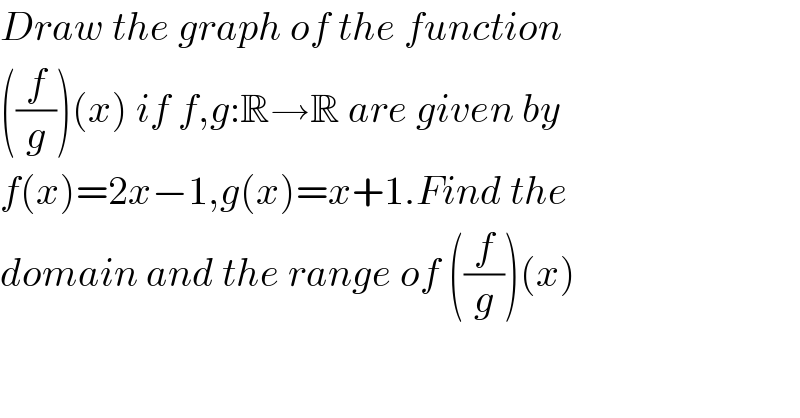
Question Number 24821 by NECx last updated on 26/Nov/17

$${Draw}\:{the}\:{graph}\:{of}\:{the}\:{function} \\ $$$$\left(\frac{{f}}{{g}}\right)\left({x}\right)\:{if}\:{f},{g}:\mathbb{R}\rightarrow\mathbb{R}\:{are}\:{given}\:{by} \\ $$$${f}\left({x}\right)=\mathrm{2}{x}−\mathrm{1},{g}\left({x}\right)={x}+\mathrm{1}.{Find}\:{the} \\ $$$${domain}\:{and}\:{the}\:{range}\:{of}\:\left(\frac{{f}}{{g}}\right)\left({x}\right) \\ $$$$ \\ $$
Answered by mrW1 last updated on 27/Nov/17

$${h}\left({x}\right)=\frac{{f}\left({x}\right)}{{g}\left({x}\right)}=\frac{\mathrm{2}{x}−\mathrm{1}}{{x}+\mathrm{1}}=\frac{\mathrm{2}{x}+\mathrm{2}−\mathrm{3}}{{x}+\mathrm{1}}=\mathrm{2}−\frac{\mathrm{3}}{{x}+\mathrm{1}} \\ $$$${Domain}:\:{x}\in\left(−\infty,−\mathrm{1}\right)\:{and}\:\left(−\mathrm{1},+\infty\right) \\ $$$${Range}:\:\left(−\infty,\mathrm{2}\right)\:{and}\:\left(\mathrm{2},+\infty\right) \\ $$
